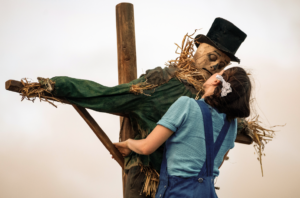Before swine

Movie ReviewPearlDirected By Ti West
(Warning: plot twists discussed in explicit detail).
TI WEST’s Pearl (2022) is several things at once: 1.) a horror film; 2.) a prequel; 3.) a claustrophobic character sketch of two women percolating in a pressure-cooker setting.
Call the film West’s attempt, successful or unsuccessful, at feminist horror. Two powerful women, one innocent, the other all too painfully aware, hiding away from the world — ostensibly out of fear (it’s 1918 and the Spanish flu held illimitable dominion over all), later (it’s suggested) for more covert reasons.
Ruth (Tandi Wright) is a god-fearing woman trying to run her farm, care for her infirm husband (Matthew Sunderland), keep her daydreaming daughter Pearl (Mia Goth) grounded and it’s a struggle: the farm is an uphill climb of backbreaking chores, the husband an endless cycle of cleaning and feeding, cleaning and feeding. Pearl is a struggle of a different kind: she’s perfectly healthy — perhaps too healthy — and has notions of someday leaving the farm with her husband Howard (who is fighting in the trenches of the First World War) or leaving the farm to become a dancer. Ruth has bound Pearl with a strict regimen of rules and routines, mostly using the pandemic and fear of a largely unknown world as an excuse. You can go out and try, she tells Pearl with relish, but you’ll always end up here with me.
But Pearl’s too full of drive. In the first half the film turns out to be that kind of horror story, of a repressive mother trying to bury her daughter under the tedium of domesticity. Odd details mar the story’s surface though, throw the viewer off: why when Ruth lays down the law is there an extra tremble to her voice? Why when she glares at Pearl is her look a tad too intense, her posture a bit too stiff, as if she’s willfully ignoring an immediately apparent fact? And why, when a goose stands arrogantly before the young woman, does her grip tighten round the pitchfork shaft?
As Pearl spreads tentative wings and explores (furtively, behind her mother’s back) that outer world in earnest, meeting a movie projectionist (David Corenswet) in the big city on the sly, agreeing to accompany her sister-in-law Mitsy (Emma Jenkins-Purro) to a dance audition (hoping to win a part for herself), Ruth responds with more panic than anger. She sees things, she tells Pearl; she knows more than her daughter thinks she knows — and as Ruth says this the words sound less like a warning and more like an admission. Around this point the film turns into a different kind of horror story: from monstrous mother oppressing innocent child to monstrous child surging past hard-pressed mother’s tenuous grasp.
It’s a measure of West’s achievement, directing from a script by Goth, that he uses the point-of-view camera (from Hitchcock by way of John Carpenter) in such a deft distinct way, suggesting, yes, much of this is being told through Pearl’s eyes, but Pearl isn’t understanding everything she sees, and watching her we don’t fully understand either. Why does Ruth weep alone behind closed doors? Why is the projectionist so gentle in his attempted seduction of Pearl? Why, when Mitsy sees the roast pig heaving with maggots at Pearl’s front porch, does she step in anyway, sitting at the kitchen table and asking Pearl to confide in her? Pearl sidles along hallway and alley, through rows of high corn, and encounter mystery after mystery; the camera sidles alongside and we gaze at Pearl herself, the film’s central mystery. West’s previous film, X, chronicles the sequel to all this, a behind-the-scenes porn comedy turned slasher horror that takes inspiration from The Texas Chainsaw Massacre, which makes sense — slasher begets slasher. But a slasher inspired by Douglas Sirk?
Makes perverse sense: Sirk’s camera glides warily through the garish-colored sets of his films and recognized the artificiality of 1950s society; his protagonists attempt to defy (or are destroyed by) this artificiality. West’s glides through Pearl’s farmhouse and recognizes in turn the artificiality of her family life; family and acquaintances walk into that artificiality at their peril.
Plus, there’s a pleasure to be had — Hitchcock by way of Carpenter — in the long-take suspense sequence, the danger generated not by a sudden shock cut but by carefully crafted mis-en-scene, emphasized by a slow stalking camera (I refer in particular to Mitsy exiting Pearl’s farmhouse to leave in her car). You can see what’s coming, you know what’s coming, but knowledge and inevitability doesn’t diminish the impact — if anything enhances it, gives you the sense of a car in a slow-motion skid, front fender pointed straight at the guard rail.
As Ruth, Tandi Wright delivers a large-scale portrait of the strict ascetic mom with a heavy Teutonic accent, then furtively shows you the cracks in the facade, the fear and loneliness of a woman raising a dangerous prodigy by herself for so long. And there’s love — that’s the sting of it; you get the sense that Ruth does at some level love her daughter, has sacrificed her own well-being for years trying not so much to imprison Pearl as shelter her from an unwitting, uncaring world. Jenkins-Purro and Corenswet as Mitsy and Pearl’s bohemian projectionist represent that larger world, decent everyday people who make the effort to try reach out to the young woman, and are burned in the process.
Mia Goth’s Pearl is all yearning and love but when that love is rejected she short-circuits and lashes out. Something’s missing in her, something that should have helped her recognize what in Ruth and Mitsy and her bohemian lover draws them to her, is her cue to respond in kind — and that lack or gap or (if you like) defining absence in her is the source of the film’s horror. Philip K. Dick once proposed that this difference is what separates humans and non-humans, even wrote a book about it (Do Androids Dream of Electric Sheep?) that has been adapted into at least two films (Blade Runner; Blade Runner 2049). Goth’s heroine is one more case study on the issue, and the sting of it is that we still care; we still root for Pearl because something in even the best of us is terrified of rejection and loneliness, is terrified of the monster in us, suddenly exposed for all to see.




